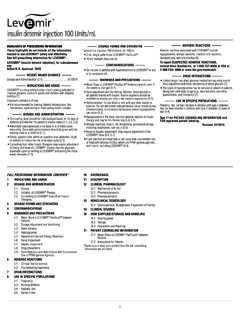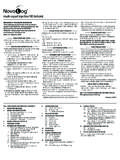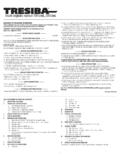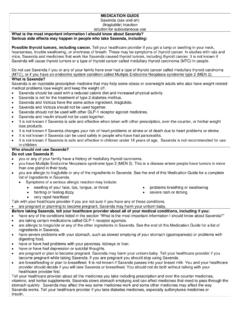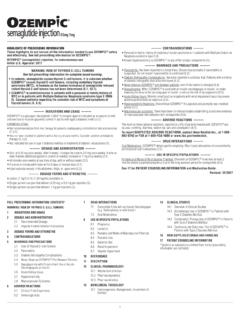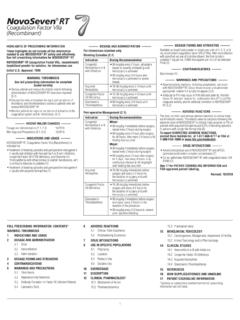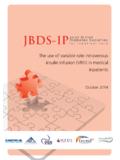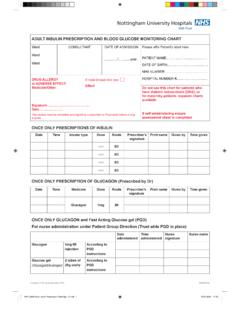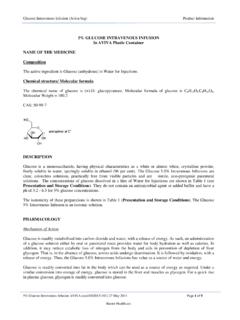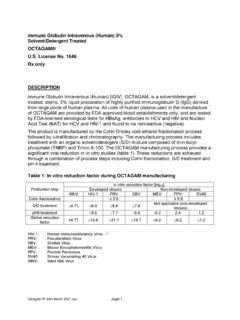Transcription of HIGHLIGHTS OF PRESCRIBING INFORMATION …
1 HIGHLIGHTS OF PRESCRIBING INFORMATION These HIGHLIGHTS do not include all the INFORMATION needed to use FIASP safely and effectively. See full PRESCRIBING INFORMATION for FIASP. FIASP ( insulin aspart injection) for subcutaneous or intravenous use Initial Approval: 2000 -------------------------INDICATIONS AND USAGE----------------------------- FIASP is a rapid-acting human insulin analog indicated to improve glycemic control in adults with diabetes mellitus (1). ----------------------DOSAGE AND ADMINISTRATION---------------------- Individualize and adjust the dosage of FIASP based on route of administration, individual s metabolic needs, blood glucose monitoring results and glycemic control goal ( ). Dosage adjustments may be needed when switching from another insulin , with changes in physical activity, changes in concomitant medications, changes in meal patterns, changes in renal or hepatic function or during acute illness ( ).
2 Su bcutaneous injection ( ): o Inject at the start of a meal or within 20 minutes after starting a meal into the abdomen, upper arm, or thigh. o Rotate injection sites within the same region. o Should generally be used in regimens with an intermediate- or long-acting insulin . intravenous Infusion: Administer only under medical supervision after diluting to concentrations from 0. 5 to 1 unit/mL insulin aspart in infusion systems using polypropylene infusion bags ( ). ---------------------DOSAGE FORMS AND STRENGTHS--------------------- Injection: 100 units/mL (U-100): 10 mL multiple-dose vial (3) 3 mL single-patient-use FIASP FlexTouch pen (3) -----------------------------CONTRAINDIC ATIONS------------------------------ During episodes of hypoglycemia (4).
3 Hypersensitivity to insulin aspart or one of the excipients in FIASP (4). -----------------------WARNINGS AND PRECAUTIONS---------------------- Never share a FIASP FlexTouch pen between patients, even if the needle is changed ( ). Hyper- or hypoglycemia with changes in insulin regimen: Carry out under close medical supervision and increase frequency of blood glucose monitoring ( ). Hypoglycemia: May be life-threatening. Increase frequency of glucose monitoring with changes to: insulin dosage, co-administered glucose lowering medications, meal pattern, physical activity; and in patients with renal impairment or hepatic impairment or hypoglycemia unawareness ( ). Hypoglycemia due to medication errors: Accidental mix-ups between insulin products can occur.
4 Instruct patients to check insulin labels before injection ( ). Hypokalemia: May be life-threatening. Monitor potassium levels in patients at risk for hypokalemia and treat if indicated ( ). Hypersensitivity reactions: Severe, life-threatening, generalized allergy, including anaphylaxis, can occur. Discontinue FIASP, monitor and treat if indicated ( ). Fluid retention and heart failure with concomitant use of thiazolidinediones (TZDs): Observe for signs and symptoms of heart failure; consider dosage reduction or discontinuation if heart failure occurs ( ). --------------------------------ADVERSE REACTIONS---------------------------- Adverse reactions observed with FIASP include: hypoglycemia, allergic reactions, hypersensitivity, injection site reactions, lipodystrophy, and weight gain ( ).
5 To report SUSPECTED ADVERSE REACTIONS, contact Novo Nordisk Inc. at 1-800-727-6500 or FDA at 1-800-FDA-1088 or ---------------------------------DRUG INTERACTIONS---------------------------- Drugs that Increase Hypoglycemia Risk or Increase or Decrease Blood Glucose Lowering Effect: Adjustment of dosage may be needed; closely monitor blood glucose (7). Drugs that Blunt Hypoglycemia Signs and Symptoms ( , beta-blockers, clonidine, guanethidine, and reserpine): Increased frequency of glucose monitoring may be required (7). See 17 for PATIENT COUNSELING INFORMATION and FDA-approved patient labeling. New: 09/2017 FULL PRESCRIBING INFORMATION : CONTENTS* 1 INDICATIONS AND USAGE 2 DOSAGE AND ADMINISTRATION Important Administration Instructions General Dosing Instructions 2.
6 3 Converting to FIASP from Other Insulins in Patients with Either Type 1 or Type 2 Diabetes 3 DOSAGE FORMS AND STRENGTHS 4 CONTRAINDICATIONS 5 WARNINGS AND PRECAUTIONS Never Share a FIASP FlexTouch Pen Between Patients Hyperglycemia or Hypoglycemia with Changes in insulin Regimen Hypoglycemia Hypoglycemia Due to Medication Errors Hypokalemia Hypersensitivity and Allergic Reactions 5. 7 Fluid Retention and Congestive Heart Failure with Concomitant Use of PPAR-Gamma Agonists 6 ADVERSE REACTIONS Clinical Trial Experience Immunogenicity 7 DRUG INTERACTIONS 8 USE IN SPECIFIC POPULATIONS Pregnancy Lactation 8. 4 Pediatric Use Geriatric Use Renal Impairment Hepatic Impairment 10 OVERDOSAGE 11 DESCRIPTION 12 CLINICAL PHARMACOLOGY Mechanism of Action Pharmacodynamics Pharmacokinetics 13 NONCLINICAL TOXICOLOGY Carcinogenesis, Mutagenesis, Impairment of Fertility 14 CLINICAL STUDIES Overview of Clinical Studies Type 1 Diabetes - Adults Type 2 Diabetes - Adults 16 HOW SUPPLIED/STORAGE AND HANDLING How Supplied Recommended Storage 17 PATIENT COUNSELING INFORMATION *Sections or subsections omitted from the full PRESCRIBING INFORMATION are not listed.
7 FULL PRESCRIBING INFORMATION 1 INDICATIONS AND USAGE FIASP is indicated to improve glycemic control in adults with diabetes mellitus. 2 DOSAGE AND ADMINISTRATION Important Administration Instructions Always check insulin label before administration [see Warnings and Precautions ( )]. Inspect visually for particulate matter and discoloration. Only use FIASP if the solution appears clear and colorless. Train patients on proper use and injection technique before initiating FIASP. DO NOT administer FIASP intramuscularly. DO NOT dilute or mix FIASP with any other insulin products or solutions, except infusion fluids. General Dosing Instructions Individualize the dosage of FIASP based on the patient s metabolic needs, blood glucose monitoring results, and glycemic control goal.
8 Dose adjustments may be needed when switching from another insulin , with changes in physical activity, changes in concomitant medications, changes in meal patterns ( , macronutrient content or timing of food intake), changes in renal or hepatic function or during acute illness to minimize the risk of hypoglycemia or hyperglycemia [see Warnings and Precautions ( , ) and Drug Interactions (7)]. Subcutaneous Injection: Inject FIASP at the start of a meal or within 20 minutes after starting a meal subcutaneously into the abdomen, upper arm, or thigh. Rotate injection sites within the same region from one injection to the next to reduce the risk of lipodystrophy [see Adverse Reactions ( )]. FIASP given by subcutaneous injection should generally be used in regimens with intermediate or long-acting insulin [see Warnings and Precautions ( )].
9 Instruct patients on basal-bolus treatment who forget a mealtime dose to monitor their blood glucose level to decide if an insulin dose is needed, and to resume their usual dosing schedule at the next meal. intravenous Administration: Administer FIASP intravenously only under medical supervision with close monitoring of blood glucose and potassium levels to avoid hypoglycemia and hypokalemia [see Warnings and Precautions ( , )]. Dilute FIASP to concentrations from unit/mL to 1 unit/mL insulin aspart in infusion systems using polypropylene infusion bags. FIASP is stable at room temperature for 24 hours in sodium chloride or 5% dextrose infusion fluids [see How Supplied/Storage and Handling ( )] Converting to FIASP from Other Insulins in Patients with Either Type 1 or Type 2 Diabetes If converting from another mealtime insulin to FIASP, the change can be done on a unit-to-unit basis [see Clinical Studies (14)].
10 3 DOSAGE FORMS AND STRENGTHS Injection: 100 units of insulin aspart per mL (U-100) is available as a clear and colorless solution in: 10 mL multiple-dose vial 3 mL single-patient-use FIASP FlexTouch pen 4 CONTRAINDICATIONS FIASP is contraindicated During episodes of hypoglycemia [see Warnings and Precautions ( )]. In patients with known hypersensitivity to insulin aspart or one of the excipients in FIASP. [see Warnings and Precautions ( )]. 5 WARNINGS AND PRECAUTIONS Never Share a FIASP FlexTouch Pen Between Patients FIASP FlexTouch disposable prefilled pen should never be shared between patients, even if the needle is changed. Patients using FIASP vials should never share needles or syringes with another person. Sharing poses a risk for transmission of blood-borne pathogens.
